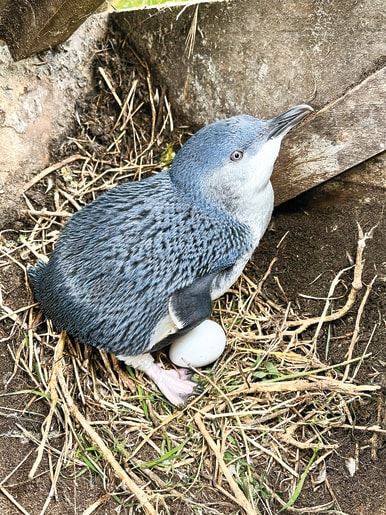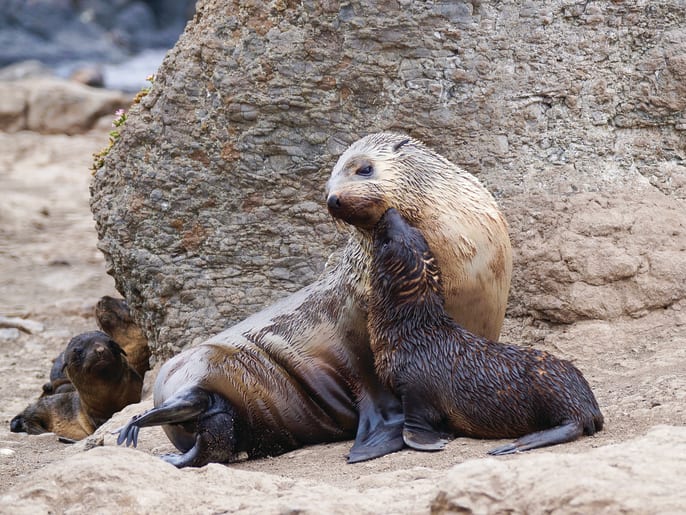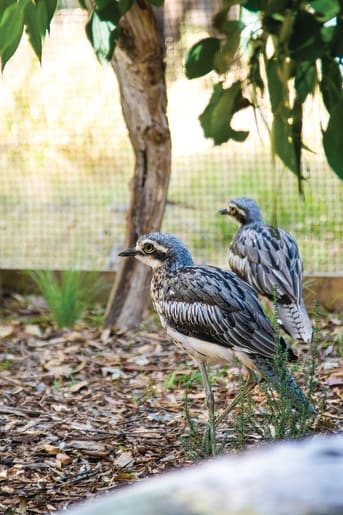
During winter, Flame Robins arrive on our shores from Tasmania.

Over autumn on Phillip Island, there has been an increase in numbers coming ashore with some breeding behaviours observed, and some eggs found by the Nature Parks’ research team.

During winter, the Australian fur seal (Mering-mum) pups on Seal Rocks are growing strong and have moulted their black lanugo (downy) coat.

The Koala Conservation Reserve is currently home to bush stone-curlews housed in two large aviaries where visitors can see and learn about the species and their proposed recovery.
By Phillip Island Nature Parks
Environment
As the weather turns cooler there are still plenty of reasons to get out into nature on Phillip Island.
Wildlife are busy in their ecosystems and plants are blooming despite the winter chill, while our team remain busy across all areas of the parks.
Read on to find out about what is going on behind the scenes this winter at Phillip Island Nature Parks.
In the skies – birdlife
Hooded Plover
During winter, many Hooded Plovers and their young leave nesting territories and move into small flocks to feeding beaches on and off the island.
Hooded Plovers will start breeding again in late August to early September, look out for signage and roped nest refuges. You can help them by walking on the wet sand as you pass by and keeping dogs on lead.
Short-tailed Shearwaters (Py-er-din / Biyadin)
The 2023 Dark Sky So Shearwaters Fly campaign has wrapped up. The shearwater adults and chicks have now left our shores.
A huge thank you to everyone for supporting these amazing birds, switching off your lights and helping to make the annual migration from the island such a success.
The chicks have now completed their first migration, utilising the strong westerly winds to follow their parents north. Their journey takes them past New Zealand, towards Japan. They then skirt past Siberia to Alaska and can be found off the coast of North America.
Bird Life
In winter, a number of birds arrive to Phillip Island after migration, including flame robins who add a flash of winter colour to the Island, after arriving on our shores from Tasmania.
Birds of prey such as black-shouldered kites, marsh harriers and falcons are very active and can be seen hovering or soaring over dunes, roadsides, and wetlands. Kites are specialist mice hunters and hunt at dawn or dusk from perches or by hovering, perfectly still, above their prey. Head to Swan Lake to see the peregrine falcons.
Wedge-tailed Eagles (Bunjil) may be seen circling over farmland. These are Australia’s largest bird of prey with a wingspan of 2.3 metres.
Tiny birds called Silvereyes arrive on our shores after making their annual trek across the Bass Strait from Tasmania. Researchers believe they cross the Bass Strait by island hopping. Look for them feeding on fruits, nectar and insects in bush and coast reserves – even in your garden!
On the ground
Echidnas (Row-un)
The Bunurong name for a short-beaked echidna is Row-un, and this time of year the echidnas are breeding.
In winter, females attract males, selecting one as a mate. A lone female being followed by several males is called an "echidna love train". As always, be wary of our spiny friends on roads.
Eastern Barred Bandicoots (Ty-ung / Boe-ung)
Only five years ago, this endangered species was very near to extinction, but we are thrilled to be able to say that Phillip Island is now home to a thriving population of Eastern Barred Bandicoots.
You may be lucky enough to see bandicoots in your own backyard, or close to your home.
Being nocturnal these amazing critters are active at night and hence may also be spotted close to or on our roads. To help ensure their safety please be aware of the following:
- They are most active at night, so from sunset onwards keep your eyes out for them.
- To help spot them on the road as you drive, look for movement and eye-shine, both on the road and on the verges where they may be foraging.
- At first sight at night, they may be mistaken as a rabbit, but are noticeably smaller and their long nose and striped rump distinguishes them from a rabbit.
- Reduce your speed to conditions and be particularly careful on main roads in areas with higher density, including Back Beach Road (especially around Kitty Miller Road), Ventnor Road, Cape Woolamai and Newhaven.
- If you hit an Eastern barred bandicoot, please stop to check the animal if safe to do so. Otherwise call Wildlife Victoria on (03)8400 7300 and a trained volunteer will assist.
- If you see an Eastern barred bandicoot anywhere on Phillip Island, please help us by recording your sighting at ebb.natureparksresearch.com.au/sighting/
Bush Stone-Curlews
The reintroduction of bush stone-curlews is in progress for 2024. The team has been working closely with our partners, Odonata and The Australian National University, in the recovery of bush stone-curlews across south-eastern Australia.
Fox-free Phillip Island is proposed as a key hub for the recovery of this species, which is listed as Critically Endangered in Victoria.
The Koala Conservation Reserve is currently home to bush stone-curlews housed in two large aviaries where visitors can see and learn about the species and their proposed recovery on Phillip Island. These birds have produced a couple of chicks, which will feed into the program to recover the species in the wild.
We are currently developing an updated feasibility and translocation plan which incorporates the latest science and monitoring methods to give this challenging recovery the best chance of success.
Tracks and trails
Cape Woolamai is Phillip Island’s highest point, boasts one of the area’s best surfing spots, and is home to the largest shearwater sea-bird rookery.
Grab your binoculars and get out to one of the stunning walks at Cape Woolamai for a spot of whale watching. From May to October, humpback whales, southern right whales and orcas migrate from Antarctica to the warmer waters in Queensland for calving.
Time: Varies - 1.5 to 4 hours. Distance: 4.5 to 8 kilometres. Difficulty: Moderate
There are three walks that start and finish at the Cape Woolamai Surf Lifesaving Club car park including the Pinnacle Loop, a four-kilometre walk that will take roughly two hours and will guide you to the iconic pinnacles; a collection of unique granite rock structures formed from ancient volcanic activity. To read more: www.penguins.org.au/attractions/reserves/capewoolamai/
Flora
Though winter may seem much less of a season for plants compared to spring or summer, there is still plenty happening with our local flora. From the golden glow of the she-oaks to the cheerful lemon-yellow banksia flowers, there are plenty of blooms to brighten a grey winter day.
Allocasuarina verticillata, or the dropping she-oak blooms during May to July. These plants are dioecious, meaning they are either male or female, and this time of year is the best time to tell them apart. The male plants have golden pollen as their flowers, while the female plants have the characteristic spiky seed cones that appear if their red fuzzy flower is pollinated by a male plant. They tend to bloom when the winds are strong to increase their chances of successful pollination. Keep your eyes peeled for these beautiful trees. Your best bet to find them on the island is to head to Swan Lake.
Foreshore management
Woolamai Surf Life Saving Club upgrades
Woolamai Beach Surf Life Saving Club has received funding through the Australian government’s Building Better Regions fund to streamline emergency and public access to the beach, club house and toilets, and better protect the sensitive coastal environment.
These works will include sand relocation and dune vegetation works near the Life Saving Club, located on Phillip Island Nature Parks’ managed land, to address ongoing sand and inundation issues at the club; pathways and ramps will be upgraded to improve access; and a new retaining wall will be built on the southern and western sides of the club. Find out more at www.penguins.org.au/about/local-community/news/wbslsc
Future proofing Little Penguin habitat
To reduce bushfire risk, protect penguin habitat and create green fuel breaks, non-burn vegetation treatments and planting of 40,000 new fire-retardant plants is being conducted at the Summerland Peninsula.
The works will improve and maintain firebreaks to reduce flammability and reduce land temperature and limit the intensity and impacts of any future bushfires on wildlife and the environment.
To learn more and stay up to date, visit www.penguins.org.au/about/local-community/news/future-proofing-little-penguin-habitat/
Pyramid Rock toilets upgrade
As part of the Phillip Island Nature Parks asset renewal program, in the coming months the current Pyramid Rock Toilets will be replaced by a new, accessible, gender-neutral facility. This project is supported by the Victorian government Department of Families, Fairness and Housing as part of the Universal Design Funding Round 2022.
In The Trees
Koalas (Gurrborra)
The Koala Conservation Reserve is preparing their plantations for planting season to ensure the growth of a variety of eucalyptus species over the coming months that will be used for supplementary koala feeds within in the reserve.
There are around 700 species of eucalypt in Australia and koalas feed on around 40 of these species. Rangers will be planting with assistance from the Bunurong Land Council Aboriginal Corporation over the coming months. Eucalypt species that will be included in this project are Manna Gum (Eucalyptus viminalis), which is the preferred species of our koalas at the Koala Conservation Reserve,
Swamp Gum (Eucalyptus ovata), Blue Gum (Eucalyptus globulus), Long-leaved Box (Eucalyptus goniocalyx) and Messmate Stringybark (Eucalyptus obliqua).
Providing koalas with supplementary feed all year round reduces browsing pressure of the trees at the Koala Conservation Reserve.
As the weather gets colder here in Victoria our koalas in the reserve will often be seen on the boardwalks and viewing areas tucking up into a ball to remain warm and preserve heat.
On our shores and in our waters
Little Penguins (Guyup)
In the world of little penguins, during winter the local food abundance can drop due to colder water temperatures. Satellite tracking of little penguins in 2008 found the at-sea-movements and foraging range of little penguins (Eudyptula minor) changes in response, they might go into Port Phillip Bay and even as far as Warrnambool.
The short days and wintry weather can make for a harder time of year for little penguins, but luckily, they are well equipped to deal with the icy waters with their waterproof feathers that act like a doona inside a wetsuit.
At this time of year, many individuals conduct single day trips, but some can go much farther and stay out at sea for over a month. Despite these long feeding trips, penguins still come ashore each evening at Phillip Island.
Over autumn, there has been an increase in numbers coming ashore with some breeding behaviours observed. There have been some eggs found by our research team, however usually once the cold winter hits these attempts are abandoned. Sometimes, like last year, a small number of individuals power through all winter. Find out the outcome in our Spring edition of Know Your Nature Parks.
Seal Rocks news
During winter, the Australian fur seal (Mering-mum) pups on Seal Rocks are growing strong and have moulted their black lanugo (downy) coat. Their new silver coat of fur means they are waterproof and able to spend more time in the water.
Australian fur seals have two layers of fur that keep them warm and dry while at sea, and the nails on their flippers allow grooming of their fur to stay waterproof or scratch an itch. By August the pups are learning to catch fish for themselves.
Keeping wildlife wild
The greatest thing you can do for wildlife is to keep it wild. Please always keep your distance and remember how lucky we are to be able to share our beautiful island home.
Take care when driving on Phillip Island especially at dawn, dusk and at night when wildlife is most active. To report injured wildlife, call Wildlife Victoria on (03) 8400 7300.
For more information on living with wildlife please visit www.wildlife.vic.gov.au/protecting-wildlife/protecting-wildlife.
Don't forget to share your Nature Parks images with us by using our hashtag #PhillipIslandNP.





